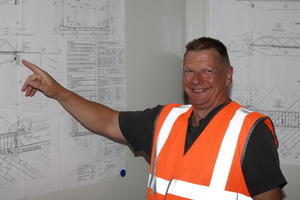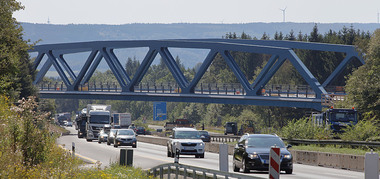Stefan Dienst, Project Manager
"Better to invest in bridges than road closures!"metallbau: Mr. Dienst, how did the building project come about?
Stefan Dienst: The two previous bridges were completed around the same time in 1966 and formed part of the early construction phase of the A45, whose construction was completed in the early 1980s. The two bridges belong to the B54, which runs in this region roughly in parallel to the motorway for a few kilometres. Tests indicated that these bridges had insufficient load bearing capacity, but their renovation was not an economical solution, especially as their dimensions prevented the development of a six lane motorway.
First of all, we tested a bridge-free version and a complete relocation of the motorway route to the east of the original motorway. Nevertheless, this version failed early on due to the topography, nature and local opposition.
metallbau: Why was the motorway closed on one side?
Dienst: At the same time, the Kalteiche valley bridge on A45 to the south is also being renovated. With this in mind, a 4+0 lane system has been set up, the motorway towards Gießen has been closed and the traffic has been fully routed on the other side of the motorway. It made sense to continue this approach because it eliminated the need to set up another central reservation crossing and no further continuous marking work was required depending on the site progress. Furthermore, one even a very long 4 + 0 lane system is less prone to accidents than two short consecutive construction sites with corresponding lane changes.
metallbau: Why were the bridges prefabricated adjacent to their future site?
Dienst: In any case, we wanted to avoid so-called island construction sites, i.e. avoiding work on the central reservation, as these lead to further road marking work and even more accidents.
The Chief Engineer responsible for North Hesse, Dipl.-Ing. Harald Mank, my boss, represents the guideline that it would be better to put the money into the bridges than in auxiliary constructions. Especially as such permanent road marking and closure work are not in vain.
metallbau: How did you get involved in the construction?
Dienst: Hessen.Mobil, the road and traffic management of the state of Hesse, has a planning department, where we first of all developed different variants and compared them in terms of their cost effectiveness and feasibility. In doing so, we established that a higher and more attractive arch bridge would be constructively feasible for the longer southbound bridge. We rejected the variant, however, due to the increased driving effort: For this purpose, its bows would have to be upgraded with temporary auxiliary constructions.
metallbau: How were orders allocated and execution planned?
Dienst: Here Hessen.Mobil broke new ground by opting for early execution planning. For example, we had already begun execution planning at the time of the variant stage and were thus able to forecast the actual construction cost of around 15 million euros to a very precise level, without any additional costs. Although Hessen.mobil has its own planning department, we commissioned Sweco in advance for the execution planning, an engineering company based in Frankfurt. The structural analysis was provided by the Meyer + Schubart office in Wunstorf and the test engineer was ibN - ingenieurbau Neumann from Weiler.
The aim was to be ready with the advanced execution planning so that we could simply hand over the finished plans to the contractor as contract is awarded - to the general contractor Donges SteelTec from Darmstadt - and say: Let’s get underway! That worked very well, which is why we want to continue doing so in future!


